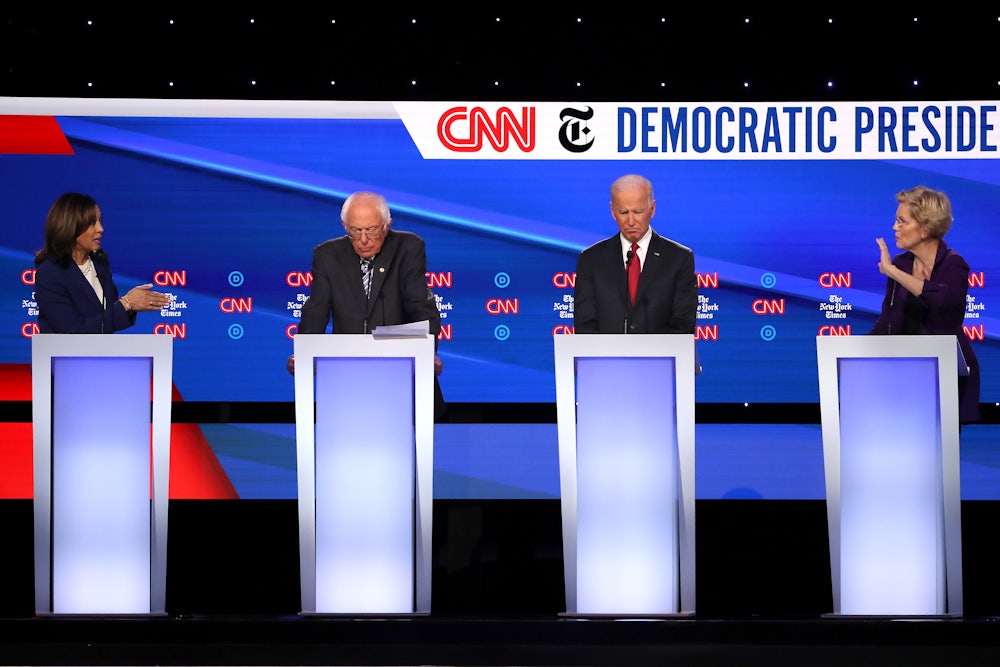Twelve Democrats met for the party’s fourth presidential debate on Tuesday night in Westerville, Ohio. The location’s electoral symbolism was hard to miss. “We’re standing in the great state of Ohio, the ultimate purple state, the ultimate bellwether state,” Andrew Yang said. “Why did Donald Trump win your state by eight points? Because we got rid of 300,000 manufacturing jobs in your towns. And we are not stopping there.”
The candidates spent much of their time debating manufacturing and automation, trade policy, the opioid crisis, and other issues that would impact how Ohioans vote next year. But they devoted no attention to whether Ohioans would be able to vote at all. Moderators from CNN and The New York Times, who jointly moderated Tuesday’s debate, didn’t ask the candidates about the national surge in voter suppression and their plans to stop it.
That marks the fourth consecutive debate where the topic went undiscussed. It’s impossible to expect that the moderators and candidates can give appropriate attention to every policy area, of course. Climate change, for example, is still perennially under-discussed in the debates given its importance. But the omission of voter suppression still stands out precisely because of the direct impact it could have on the 2020 election.
The issue is particularly salient in Ohio. Federal courts blocked the state from carrying out a sweeping purge of the voter rolls on the eve of the 2016 election. A group of civil-rights organizations had sued Ohio Secretary of State Jon Husted over his plan to remove inactive voters from the registration lists. While every state conducts some level of regular maintenance of its voter rolls to remove those who’ve either moved out of state or died, Husted argued that his supplemental process was necessary to protect the state from the threat of voter fraud, which is, was, and remains virtually nonexistent.
Civil rights groups warned that the plan, if implemented, would disenfranchise thousands of voters, particularly from lower-income and disadvantaged communities. The Supreme Court ruled last year in Husted v. A. Philip Randolph Institute that the process could go forward. “We have no authority to second-guess Congress or to decide whether Ohio’s [law] is the ideal method for keeping its voting rolls up to date,” Justice Samuel Alito wrote for the 5-4 majority, which split along traditional ideological lines. “The only question before us is whether it violates federal law. It does not.”
That process isn’t as foolproof as the state made it sound before the high court. To reassure the public about the planned purge of 235,000 registered voters, Ohio officials released the names of every voter who would be swept up in it. According to the Times, activists soon discovered that 40,000 names—roughly one-fifth of the total—were wrongly included on the state’s list for purging. The Times found that one of those names belonged to Jen Miller, the director of the League of Women Voters of Ohio, a voting-rights organization, even though she had voted in the last three federal elections.
This problem is hardly limited to Ohio. Republican-led states have slashed early-voting hours, closed hundreds of polling places, and erected new logistical and bureaucratic barriers to voting across the country. One study found that Wisconsin’s strict voter-ID policy may have kept between 12,000 and 23,000 otherwise eligible voters from casting a ballot in 2016; Trump won the state by roughly 23,000 votes. A federal judge ruled in 2017 that North Carolina’s voter-ID law violated the Fourteenth Amendment, writing that its provisions “target African-Americans with almost surgical precision.”
Candidates don’t need to wait for the moderators to ask a question about voter suppression before talking about it. In Tuesday’s debate, Kamala Harris and Cory Booker managed to discuss abortion rights in a broader conversation about access to health care. A back-and-forth exchange over the Supreme Court in the debate’s third hour would have been a perfect opportunity to note the justices’ role in the voter-suppression war. The Roberts Court’s ruling in Husted and in Shelby County v. Holder, where they gutted a key mechanism in the Voting Rights Act, effectively signaled that court’s conservative justices would not intervene to protect the franchise.
Those who hoped that the Democratic candidates would use Ohio’s struggle to highlight nationwide efforts to undermine the democratic process can take heart at the site of next month’s debate. Candidates will gather again in Georgia on November 20, just over a year after Brian Kemp, Georgia’s then-secretary of state, defeated Stacey Abrams in a gubernatorial race marred by widespread allegations of voter suppression. If the Democratic field can’t find the inspiration to discuss the threat to the rights of voters there, there will be every reason to wonder whether they understand the urgency of an issue to which all their hopes are pinned.
